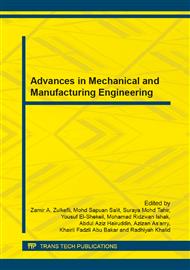p.234
p.240
p.245
p.250
p.256
p.263
p.269
p.275
p.281
Numerical Simulation of Microwave Heating for Soot Oxidation
Abstract:
This paper presents the simulation of microwave heating by coupling high frequency electromagnetic with transient heat transfer using finite element method edge base of ANSYS software. Helmholtz equation of electric field has been formulated from Maxwell equations to predict electric field and the mathematical model of transient thermal analysis was included. Three cases have been examined numerically to investigate electric field, dissipated heat, temperature distribution and weight loss of soot at operation frequency 2.45 GHz. The simulation results showed that heat is generated from inside to outside of soot. The temperature at penetration depth increased till ignition point and after further heating, maximum temperature was attained, followed by temperature decreases due to mass transport. Maximum electric field was found to be located on the front face for the small samples with dimensions less than penetration depth. The predicted results have been compared with experimental results which show the validity of the simulation.
Info:
Periodical:
Pages:
256-262
Citation:
Online since:
June 2014
Keywords:
Price:
Сopyright:
© 2014 Trans Tech Publications Ltd. All Rights Reserved
Share:
Citation:


